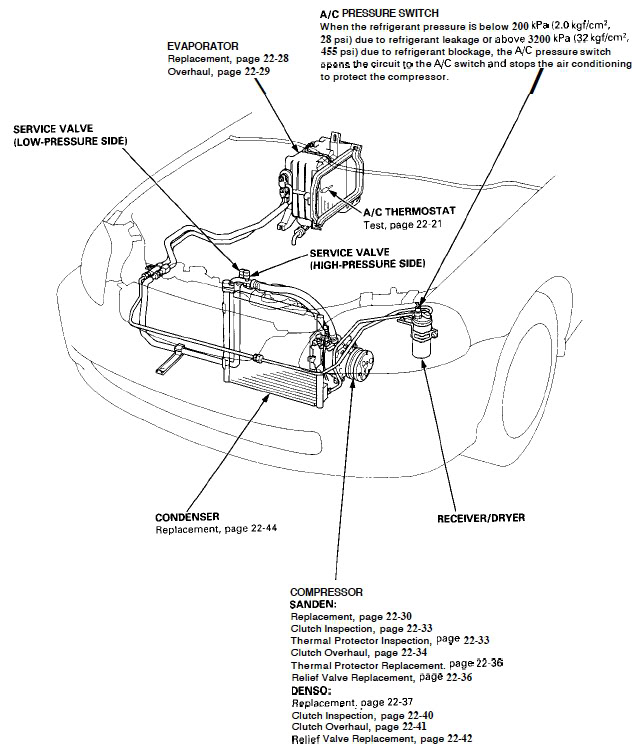Troubleshooting a Honda Civic AC involves checking the refrigerant level and inspecting the compressor. Ensure the cooling fans are operational for optimal performance.
Honda Civics, renowned for their reliability and efficiency, occasionally face air conditioning (AC) issues that can disrupt comfort during drives. Understanding the basics of AC troubleshooting is essential for Civic owners, aiming to maintain a cool and comfortable environment inside their vehicles.
This guide focuses on common problems like low refrigerant levels, faulty compressors, and non-functional cooling fans. By addressing these issues promptly, owners can avoid more significant problems down the road. Keeping the AC system in top condition ensures a pleasant driving experience, especially in warmer climates. Remember, regular maintenance checks can preempt many of these issues, keeping your Honda Civic’s AC running smoothly.

Credit: m.youtube.com
Honda Civic Ac Issues: Common Symptoms
Honda Civics are known for their reliability. Yet, AC problems can arise. This post explores common symptoms. Understand these to tackle issues early.
Warm Air Blowing
Warm air from vents is a clear sign. It could mean low refrigerant levels or a faulty compressor. Check for leaks or compressor issues.
Strange Noises During Operation
Noises when the AC runs aren’t normal. Grinding or squealing could indicate a belt problem. It’s best to inspect the system for loose components.
Initial Steps Before Troubleshooting
Honda Civic owners know the importance of a functioning AC system. Before troubleshooting, taking the right initial steps is key.
Safety Precautions
Safety always comes first. Before starting, ensure the engine is off. The parking brake should be engaged. Wear safety glasses and gloves. Keep your workspace clean and free of any hazards.
Gathering Necessary Tools
Proper tools make troubleshooting easier. You will need:
- Basic hand tools such as wrenches and screwdrivers.
- A multimeter to check electrical components.
- Refrigerant gauges for pressure checks.
- A flashlight to see in dark areas.
With these precautions and tools, you’re ready to diagnose your Civic’s AC issues.
Checking The Basics: Quick Inspection
Before diving into complex diagnostics, start with a quick inspection of your Honda Civic’s AC system. A simple check can reveal common issues that are easy to fix. Ensuring these basics are in order can often restore cool air to your cabin with minimal effort.
Ac Control Settings
First, review the settings on your AC control panel. Turn the ignition to “ON” and activate the AC. Check if the controls are responsive. Ensure the temperature is set to the coldest setting. Verify that the AC button lights up when pressed. If it doesn’t, a blown fuse could be the issue.
Cabin Air Filter Condition
Next, inspect the cabin air filter. A clogged filter restricts airflow and reduces AC efficiency. Locate the filter behind the glove box or under the dashboard, depending on your Civic model. Remove and examine it. A dirty filter needs replacement. A clean filter ensures fresh air flows smoothly.
- Turn off the engine.
- Open the glove box.
- Release the stops and lower the glove box.
- Remove the filter cover.
- Take out the filter and inspect.
These simple steps can often fix minor AC problems. They ensure your system has the best chance to provide cool air. Regular checks maintain AC performance and cabin comfort.

Credit: www.hondacivicforum.com
Refrigerant Level: The First Culprit
When your Honda Civic’s AC stops cooling, the refrigerant level might be low. This gas, also known as Freon, is crucial for a chilly breeze. Let’s troubleshoot.
How To Check Refrigerant
Checking the refrigerant is a safe start. A pressure gauge helps you test it. Follow these steps:
- Turn off the car.
- Locate the low-pressure service port.
- Attach the pressure gauge.
- Start the engine and read the gauge.
A low reading means it’s time to recharge the AC system.
Recharging The Ac System
Recharging is simple with a kit. Wear safety glasses and gloves. Follow these instructions:
- Buy the correct refrigerant.
- Attach the hose to the service port.
- Fill slowly, checking the gauge.
- Stop when you reach the right pressure.
Do not overfill. This can damage the system. If unsure, seek professional help.
Compressor Health: Heart Of The Ac
The Honda Civic’s AC compressor is vital. It circulates refrigerant and cools your car. But like any heart, it can have issues. Knowing how to troubleshoot can save you time and money. Let’s dive into identifying problems and testing your compressor’s clutch.
Identifying Compressor Issues
Compressor failure signs vary. Listen for noises, check for leaks, and observe the AC performance. Unusual sounds or a non-cooling AC could mean trouble. Look out for these:
- Strange noises when the AC is on
- AC blows warm air
- Visible leaks near the compressor
These symptoms suggest a compressor check is necessary.
Compressor Clutch Test
The compressor clutch engages and disengages the compressor. A working clutch is essential. Perform a clutch test with these steps:
- Locate the compressor in the engine bay.
- Start the car and turn on the AC.
- Observe the compressor clutch.
It should engage and spin with the AC on. If not, the clutch may be faulty.
Remember, regular maintenance keeps your Honda Civic cool and comfortable. Spot compressor issues early to avoid bigger problems.

Credit: honda-tech.com
Electrical Components: Fuses And Relays
The heart of your Honda Civic’s AC system lies in its electrical components. Fuses and relays are critical for function. They protect the system from power surges and regulate current flow. A failure here can mean a sweltering drive or a costly repair. Let’s dive into troubleshooting these vital parts.
Locating Ac Fuses
Finding the AC fuses is step one. The Civic has a fuse box under the hood and another inside the cabin. The owner’s manual shows exact locations. A diagram on the box covers also helps.
- Open the hood or cabin box cover.
- Consult the diagram for AC fuse location.
- Identify the fuse related to the AC system.
Testing And Replacing Relays
Relays are switches that control large currents with a small one. They can wear out or fail. Testing them ensures they work as they should.
- Locate the AC relay in the fuse box.
- Remove the relay with relay pliers or care.
- Test with a multimeter for continuity.
- Replace if the relay fails the test.
Always replace fuses and relays with the correct specification. Check the manual for the right type. Using the wrong parts can damage your AC system. It can also cause further electrical issues in your Honda Civic.
The Condenser’s Role In Cooling
Understanding the condenser’s role in your Honda Civic’s AC system is crucial. This key component cools hot refrigerant gas, turning it back into a liquid. This process is vital for efficient cooling. Let’s dive into how to keep your condenser in top shape.
Inspecting For Blockages
First, check your condenser for any blockages. Leaves, bugs, and dirt can block air flow. This makes cooling less effective. A flashlight can help you spot these blockages.
- Turn off your car.
- Locate the condenser. It’s in front of the radiator.
- Use a flashlight to look for debris.
Condenser Cleaning Techniques
Cleaning your condenser improves cooling. Here are easy steps to clean it:
- Wear safety gear. Gloves and goggles are important.
- Prepare a water and mild detergent mix.
- Use a soft brush to gently clean the condenser.
- Rinse with low pressure water. Avoid high pressure that can bend fins.
Note: Regular cleaning prevents buildup and ensures efficient cooling.
When To Seek Professional Help
AC issues in your Honda Civic can range from simple fixes to complex problems. Knowing when to call a professional is key to ensuring your comfort and safety on the road. Some issues are beyond the scope of DIY and require expert attention.
Complex Electrical Problems
Honda Civic AC systems may suffer from electrical issues that are not easy to diagnose. These can include problems with the wiring, fuses, or control units. Signs of electrical trouble could be:
- Inconsistent cooling
- Non-responsive controls
- Strange noises when AC is on
Attempting to fix these without the right tools and knowledge can lead to more damage. Qualified technicians have the expertise to safely resolve these issues.
When Diy Fixes Fail
If you’ve tried troubleshooting common AC problems and the system still doesn’t work, it’s time to seek help. This includes situations where:
- The AC blows warm air after refrigerant recharge
- There’s no improvement after replacing filters or fuses
- You’ve checked for leaks but found none
Professional mechanics can perform advanced diagnostics to identify the root cause. They have the tools to fix your AC quickly and efficiently.
Frequently Asked Questions
What Are Common Honda Civic Ac Problems?
Common Honda Civic AC problems include compressor failure, refrigerant leaks, faulty condenser, and malfunctioning pressure switches.
Why Is My Honda Civic Ac Not Blowing Cold?
Your Honda Civic AC may not blow cold due to low refrigerant levels, a faulty compressor, a clogged expansion valve, or a malfunctioning condenser.
How Do I Know If My Ac Compressor Is Bad On My Honda Civic?
To determine if your Honda Civic’s AC compressor is failing, listen for unusual noises during operation, check for poor cooling performance, and observe if the clutch engages properly. Frequent system leaks and a tripped circuit breaker also indicate a bad compressor.
Why Is My Honda Civic Ac Blowing Hot Air?
Your Honda Civic AC might blow hot air due to low refrigerant levels, a faulty compressor, or a clogged condenser. Regular maintenance checks can prevent these issues.
Why Is My Honda Civic Ac Not Cooling?
A clogged filter, low refrigerant levels, or a malfunctioning compressor could be the culprits behind inadequate cooling.
Conclusion
Troubleshooting the AC in your Honda Civic doesn’t have to be daunting. Armed with the right information and tips, you can address common issues effectively. Remember, regular maintenance is key to long-lasting performance. For more complex problems, consider seeking professional help.
Stay cool and drive comfortably, knowing you’re prepared for any AC hiccups on the road.













